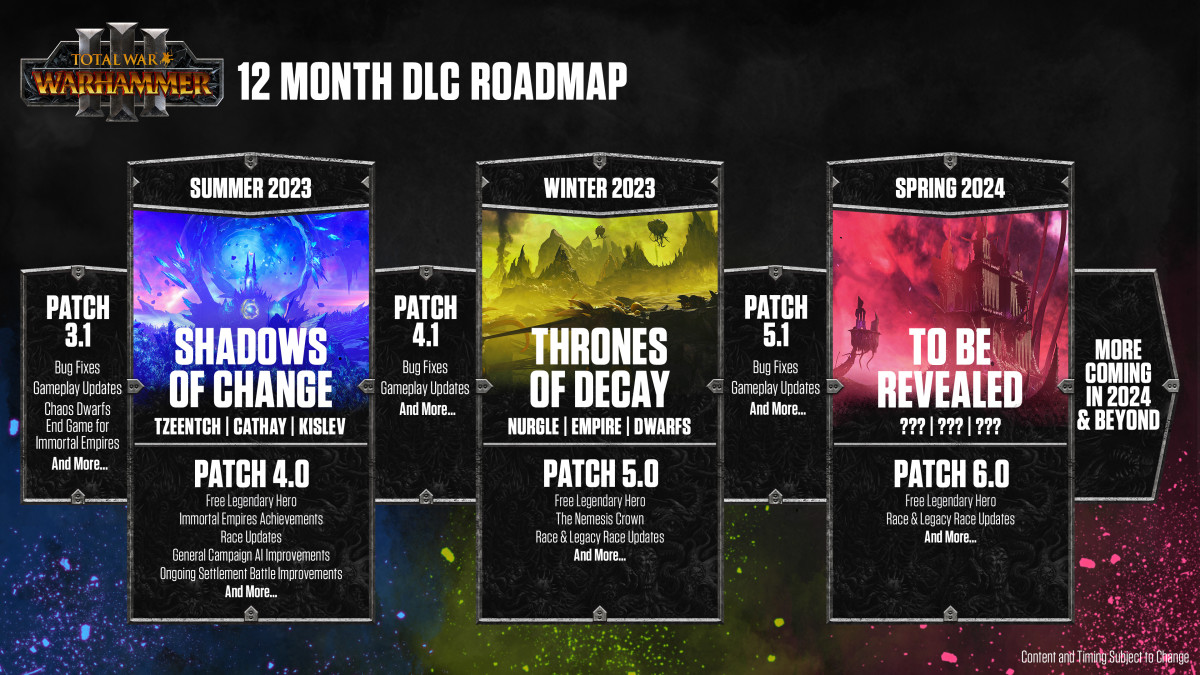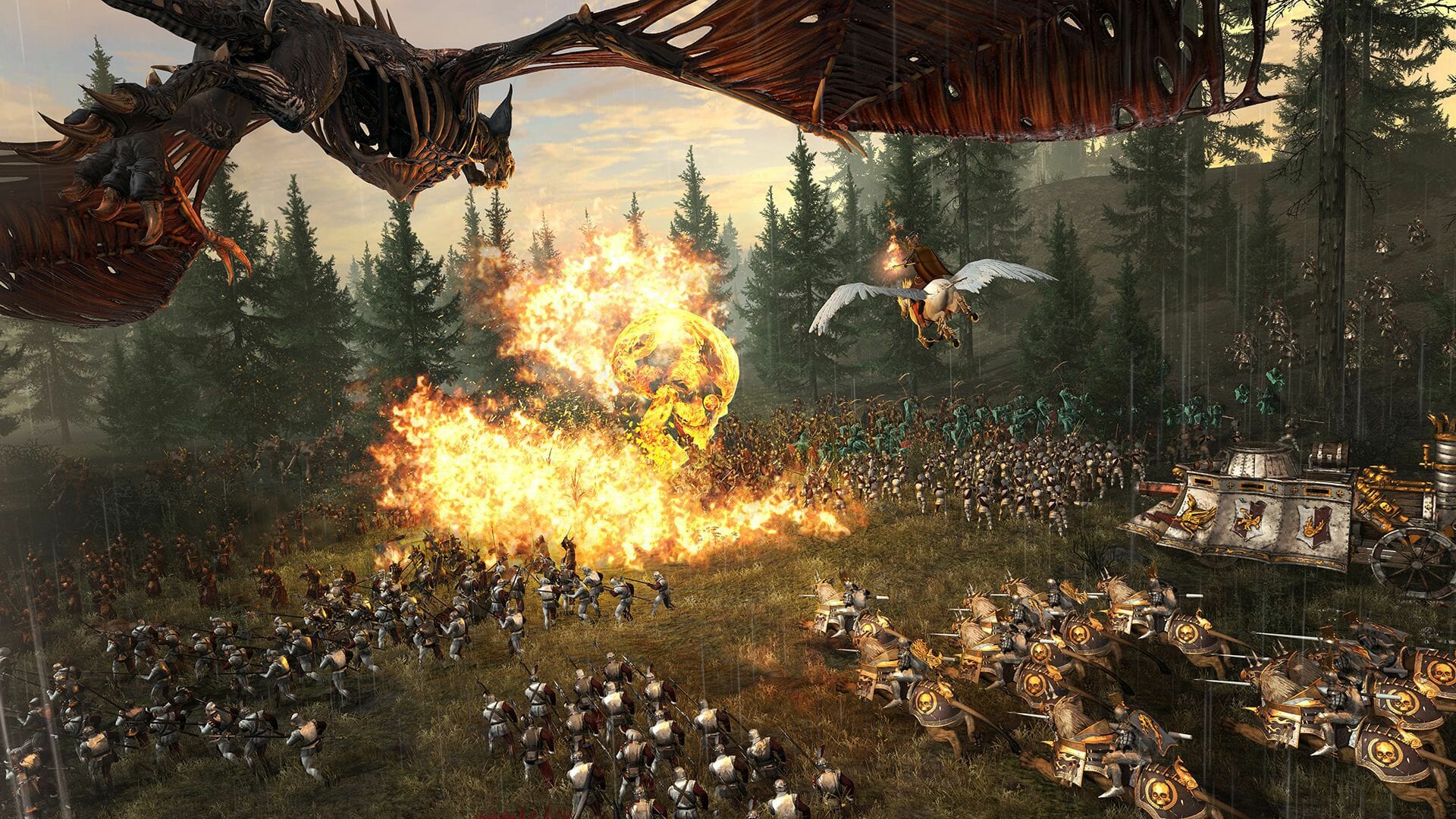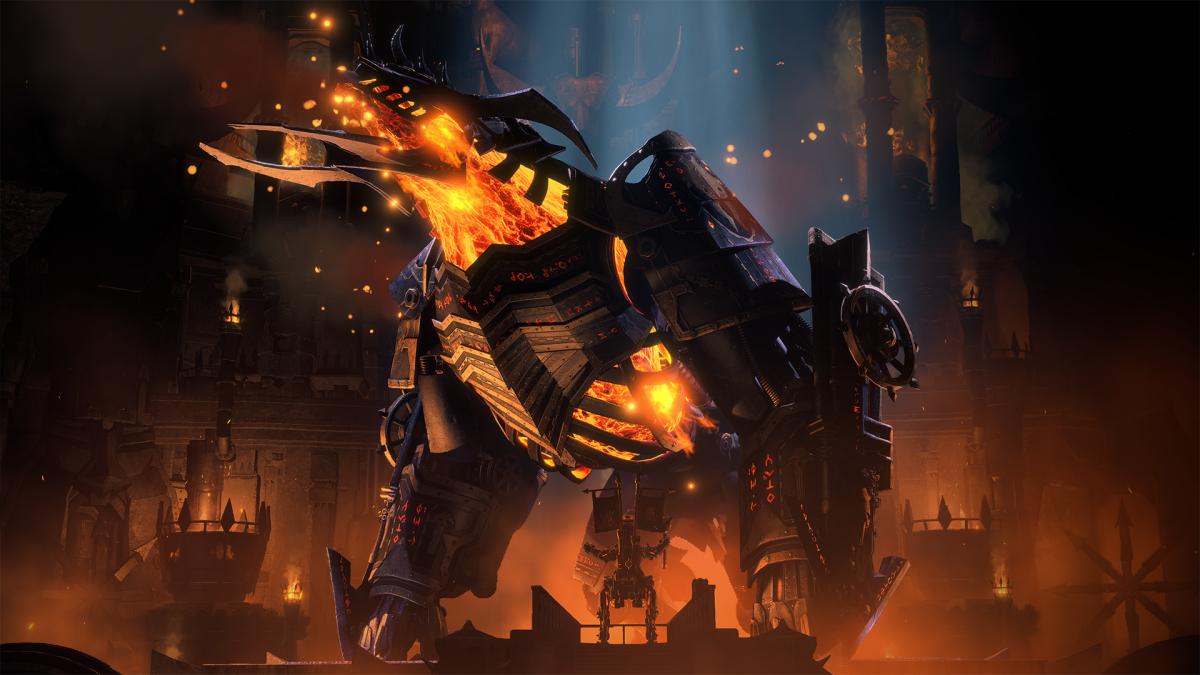Total War: Warhammer 3 developer interview – the joys and woes of working on the most ambitious strategy game to date

Games Workshop’s Warhammer Fantasy setting was built to be a home for badass warriors, earth-shattering magic, and epic battles that could happen between anyone at any location – it was designed as the background to a tabletop miniature war game, giving all of its units and factions some flavor. It was a perfect fit for Creative Assembly’s Total War series, a strategy game franchise that had built a reputation for portraying those same epic military campaigns and battles Warhammer delivered on the tabletop.
When the two UK-based companies came together to begin working on Total War: Warhammer, which was announced in 2015 as the first game of a trilogy, it turned out to be a match made in heaven. TW:WH2 followed in 2017 and proved so popular that the studio had to throw its initial and more humble plans for post-launch support out of the window. TW:WH3, today’s iteration of the series, came into play only in 2022 after years full of additional content for the second game.
We sat down with TW:WH3 game director Richard Aldridge and lead designer Mark Sinclair to look back at the series’ humble beginnings, its present state, and its promising future – from the joys and woes of development, current issues facing the team, and hints about upcoming DLC, they shared the wisdom of the Old Ones with us.
A game for everyone, everything, all at once: Immortal Empires
“We are really passionate about Warhammer,” says Richard Aldridge. “We didn’t realize it until we started this endeavor. ‘Oh, you paint the minis?’ ‘Yeah, I play the tabletop.’ ‘I read the Black Library books.’ We just felt, or I certainly did, honored to be able to work on something that I’ve grown up with and loved as a kid, making it move and fight.”
“To me it really was the dream game that I’d envisioned as a kid,” adds Mark Sinclair, who recounts battling his brother’s Dark Elves miniatures with his own High Elves during childhood. “I remember thinking with Warhammer 1, ‘Yeah, this is kind of the dream game, but I can’t actually play as those High Elves and Dark Elves, so I have to wait for Warhammer 2 to be that dream game’. And then we got to Warhammer 2 and I was like well, to have all the Daemons of Chaos and all those other factions would be great, so maybe I’ll just wait a little bit longer and then it’ll be the dream game. And now I feel like we’ve got to that point where it’s really everything.”
Sinclair is talking, of course, about Immortal Empires, a game mode included with TW:WH3 that combines the maps and factions of all three titles into one giant sandbox, bringing all that content into a single shared experience. Nothing like this has ever been done on that scale. You can pick a lord from the original game and campaign against forces half a decade younger in a region that had never before been depicted in any Warhammer medium. It’s an equally impressive and ambitious project – and the team could reasonably give itself a pat on the shoulder and declare the job well done. That, however, discounts both its ambition and passion for it.

“We just want to take it even further and do even more with it,” Aldridge says. “Immortal Empires, as much as it can almost feel like a culmination of things, it also feels like a beginning as well to us. We’ve finally got that map that we would have loved to have done originally, which was just way too big with too much stuff on it, but now we got it. So what mad ideas can we come up with and what stuff could we put into it? So it’s quite refreshing at the same time.”
Sinclair, too, calls it a “foundation” and says: “We’ve laid out the borders of our sandbox and now we just need to put more sand in it.” Both explain that the team has quite a bit of leeway and flexibility now, having learned over the years what their players expect and how far they can push Games Workshop to expand the boundaries it sets for them in terms of creativity and lore. “We get to put special colored sand in it now,” Aldridge laughs.
The game director tells me that the team has plans for at least three or four more years of support thanks to the immense depths of the Warhammer Fantasy IP – a setting that, it shouldn’t be forgotten, has been resurrected from the dead by Games Workshop and will be expanded over the coming years, which may open even more possibilities for the Total War team.
“Never say never” or a variation thereof isn’t one of Aldridge’s favorite sentences when responding to questions about the future for nothing – the truth is, things behind the scenes sometimes develop into completely unexpected directions, suddenly presenting opportunities thought impossible before. That’s how you get a Grand Cathay, which Sinclair says no one would “ever have thought of making back in Warhammer 1.” Games Workshop also suggests certain characters from time to time, the most recent example being Harald Hammerstorm, who was released as a free legendary hero to celebrate 40 years of Warhammer Fantasy.

Factions like Nippon, Ind, or Khuresh may not be realistic now, but who can say what happens in two or three years? That’s why all the empty space on the Immortal Empires map with lands that are currently not accessible to players are a sort of reserve. “At the moment, those areas aren’t to be used, or at least maybe not in the way people hope and think,” Aldridge explains.
Some content people would like to see might come to them in forms they don’t expect – Creative Assembly has already experimented with a few DLC formulas in TW:WH3 and the upcoming set of releases as detailed on the roadmap is following another brand-new recipe: three factions with a legendary lord each, a legendary hero, and plenty of reworks for older races. A big advantage of this formula, Aldridge says, is that “players get to play more stuff sooner.”
This is a lesson the team learned back in TW:WH2, when players sometimes had to wait for a long time to get more content for a specific faction while others had their time in the spotlight – back then, most DLC serviced only two races. Sinclair points out one of the disadvantages of that recipe: “Some people might have their favorite character in that pack and they’ll buy it for that and then find that maybe the other half of the pack they wouldn’t explore that much.” The intention is that these new packs will have something for everyone and give players a reason “to explore other races they might not necessarily play regularly.”

Another reason this specific type of DLC was chosen is that it would allow the team to “catch up” more efficiently – fixing older bugs, reworking existing mechanics that might not have aged very well or have been totally overshadowed by newer content. The game director adds: “We hear what everybody is asking about. We’re trying to work our way through it systematically.”
The new DLC will put players into “some different circumstances with different goals than we had in the earlier games,” Aldridge describes. He also says that all plans at the moment have Immortal Empires as well as Realms of Chaos (TW:WH3’s more narratively-driven mode that plays out on a smaller map) in mind and will add content to both experiences – this doesn’t seem to constrict the team in a creative sense, as it can always find reasons for certain characters to show up in places you might not expect them to.
For Creative Assembly, this is about offering two different experiences. While the sandbox-like nature of Immortal Empires might be more popular and more quintessentially ‘Total War’, “some people like that more focused experience,” Aldridge says. A big learning from TW:WH3’s launch, which only featured Realms of Chaos and “wasn’t quite landing as intended,” was that ideally both modes had to be serviced simultaneously in the future or at least players had to be made “more aware of what our plans are sooner”. Even more ideally, all of the narrative campaigns could be played inside Immortal Empires, including the Vortex story from TW:WH2 and mini-campaigns like the Wood Elves’ from TW:WH1, but “there’s only so many hours in a day,” as Mark Sinclair puts it.
He adds that there is a technical advantage to working on both campaigns at the same time: “Say we’re adding a new Dwarf character to Immortal Empires. That might involve updating all the buildings that the Dwarfs have and that would apply to both campaigns by default, so adding that character to the Realms of Chaos map seems like a no-brainer. It keeps the content in parity, makes our lives easier, and we don’t have to manage two entirely separate campaigns. It seems like a win-win to me.”
"It’s a big job and we’re all up for it and enjoying it."
Sinclair says that TW:WH3 is a “living and breathing game” that “belongs to all of us” – the team and the community of players. He continues: “It’s not something that we just put in a box and ship and put on store shelves and it’s done. We’ve been maintaining this for years and we’re going to do so for years to come.”
“It’s a big job and we’re all up for it and enjoying it. There’s lots more to come,” promises Aldridge.
Immortal Empires’ scale comes at a price and not everything has gone smoothly all the time. Patch 3.1, which was released about two weeks before we conducted this interview, raised some questions about the team’s ability to keep up with the immense amount of maintenance necessary for such a juggernaut of a project on top of fixing a backlog of bugs, reworking older factions, and adding brand-new content. The update seems to have caused more harm than good for some players and some changes advertised in the patch notes didn’t actually work in practice, which led to a good deal of understandable frustration. Tempers run high in the Total War community sometimes and accusations of abandonment and other things quickly get thrown around.
“We’re accountable for that and we apologize if we’ve said something that isn’t correct,” Aldridge addresses the issue. “We only want the best for this game and for the people playing it, so we are already talking about what we'll do differently next time, how we will provide the right information, and make sure that people are getting what we’re telling them. It’s a big game. It’s a lot of stuff to look after.”
There is a balance to be struck, he says, between making the fresh experiences people are after and making sure that everything players have already invested their money into works: “It’s for us to bridge that line and make sure that it’s working on both accords. Give us time. Like you saw in the prior games, we’ll get there. We’ll find our sweet spot again.”
Sinclair explains that the team is looking into improving its communication with players over the months ahead, especially in regards to upcoming reworks of older factions. Aldridge adds: “Our goal is to be more communicative going forward. I think we have improved from where we were – we were quite quiet for a period of time. Our goal is to keep informing people of the small changes we make and the big changes, because we appreciate that one thing we might say might be brilliant news to someone and maybe not of interest to someone else, but we also don’t want to come across as if this is the only change that we’re making. There’s obviously lots of bits and pieces going on in the background and we don’t want people to feel like they’re not being heard.”
"It’s become very complicated, but also very rewarding."
Adding new things and improving old things in Immortal Empires means that the developers have to re-familiarize themselves with work from years ago and somehow bring it in line with tech that has been upgraded in the meantime. “New content is exponentially harder than the previous one,” Sinclair adds. “It’s become very complicated, but also very rewarding.” While every bit of new content adds further complications, it helps keep older factions fresh as well, giving them additional challenges to face.
The team is determined to keep listening to the community. “I think they’re just as passionate as we are,” Aldridge says. “The team as a whole really embraces the idea of gathering feedback, constructive criticism, and seeing what we can do with it. There’s going to be certain things in which we’re either limited by our technology or the IP that we’re not going to do, and there are going to be other things that make us go, ‘Yeah, that’s a great idea, let’s try and incorporate that.’ It might not be immediately, it might be something that’s a slow burn. Maybe there is a piece of content in the future where that just aligns much nicer for us and we can do it justice.”
“If there is an issue in the game,” Sinclair says in regards to balancing, “that people are loud about, we’re listening and we are going to aim to address it eventually. We just need to be careful that we don’t pull that lever too far in one direction and upset the balance elsewhere and we find that makes another group of people very loud. We can’t please everyone, but that’s what we’re aiming to do.”
Aldridge describes it as an “evolving process, and it’s quite an organic one. We just want people to keep being passionate about it, giving us that feedback, and allowing us to make changes and add things.” He adds: “We’re really impressed and respect the modding community and what they do as well, how they provide updates and take the changes we make and remake them. It’s lovely to see some of the things they do and how they push some of the boundaries as well. It’s a game for everyone.”
“Is everyone else going to feel the same way?”
Today, the Warhammer series is synonymous with Total War for many players. In retrospect, it may even look like the series’ success was inevitable – a no-brainer. Despite the enthusiasm and passion on the team’s side, there was one important factor of uncertainty when it came to Total War: Warhammer – up to its release the series had always been based on real history and it was not entirely clear that the established player base would be up for a fantasy adventure.
Sinclair was confident that there was enough of a crossover between those playing the Total War games and those playing the Warhammer tabletop game as well as those that liked one of the two and could be won over for the other. For Warhammer fans “it’s that dream video game come to life” and for the Total War players it was “something completely new.” Sinclair adds that Warhammer is not totally devoid of history – sure, it’s a completely twisted version, but anyone with some knowledge of history will spot many familiar things in the setting.
Aldridge describes how the team picked up playing the tabletop game again in the conceptual stage of development and gradually came to realize that a faithful adaptation would be different from anything that had been done before in the series – so yes, there were worries about how fans would react. Factions would have to be completely asymmetrical to really be representative of their tabletop counterparts. “In Total War up to this point everyone had a little bit of everything and they could all come to the table and duke it out and that’s what made it interesting,” Aldridge says.
Now different questions arose: How would factions do without cavalry or missile units? How could you make a giant spider suitably imposing, but do it without disrupting everything about the formation-based combat the series was known for? How powerful would legendary lords be? And, most importantly, would people like or hate these changes and would this – at its core – still be a Total War game? Aldridge sums up the uncertainty: “There were some moments of, ‘Wow, this feels amazing and I can’t wait to play it, but is everyone else going to feel the same way?’”
The initial release played it relatively safe to cater to both audiences – just in case, Aldridge says, featuring very familiar fantasy races such as the Dwarfs and the Greenskins and some of the setting’s more relatable characters like Karl Franz, but very soon confidence grew as player feedback came in. Fans were not just fine with asymmetrical factions, they encouraged the team to build even more diverse and different content, “to really go to town.”

That opened the floodgate for TW:WH2 and its huge amount of additional content packs. The team went to town, bringing the Tomb Kings and even the Vampire Coast to unlife – the latter were based on a single article in White Dwarf Magazine, making them a huge surprise for the community.
Aldridge and Sinclair found themselves in the position of advisors and researchers for the whole team – audio engineers asking about a certain character’s sound and animators debating how a creature would move. There were no obvious answers, because none of these things happened on the tabletop, so Aldridge says they had to go “digging” and often rely on Games Workshop to get the most accurate information they could.
This diligence has paid off for them many times over – all three games are full of lovely easter eggs and details that have won the team praise from fans of the setting, who can sometimes hardly believe their eyes upon seeing some obscure detail from the lore being included. Wildcards like the fully-realized Norsca and Vampire Coast factions are great examples of this. The pinnacle for making fans’ dreams come true was probably the most recent Chaos Dwarfs expansion.
“We were ready to be on this train a long time ago,” says Aldridge. “I think even in the early Warhammer 1 days we knew that these guys were going to be rolling in. They looked fun with the arsenal of weapons they have, the aesthetic they have, the strong thematic that GW created around them. It was one we were looking forward to.”
So was the community, which had been waiting about five years for this moment to come. “We’ve been keeping up to date with all the forum posts and read what people wanted,” Sinclair recounts, “and I think we were able to take the time to match everyone’s expectations and exceed them with certain things you definitely didn’t expect – some of the big units like the K’daai Destroyer. That was definitely a surprise for some.”
“That’s really what we like to do,” Aldridge throws in. “We like to give people the big-ticket items they know and love from the lore, and then where we can throw a bit of a curveball, a bit of a wild card, maybe something that hasn’t seen the light of day in a very long time.”

The team wants to get the most “bang for the buck,” as Sinclair puts it, from every bit of content. This includes building a strong theme for each DLC, finding the perfect characters to throw into parts of the map that might feel a little bit stale and giving them a motivation to rough up that part of the world. We’ve touched on this before, but it’s a consideration that’s very important for the developers: Even if an expansion doesn’t contain new content for a certain faction, that content – if placed at the right spot – can still freshen up the experience of playing many other races.
Shadows of Change, which contains new toys for Tzeentch, Kislev, and Grand Cathay, is the first DLC listed on the roadmap – and with a Summer 2023 release it can’t be that far off.
You’d think they’d be running out of material at this point, but Aldridge explains that “there’s loads more content we haven’t explored yet across all different army books and across some of the supplementary rule books or novels. We do go digging quite deep and asking Games Workshop ‘are we allowed to, does that seem cool?’, so yeah, expect some good things.”
What good things would those be, just asking for a friend?
"Nothing beats a monster."
Sinclair says that Shadows of Change will have “something for everyone” with “a huge amount of content and hopefully some exciting new ways to play the game.”
“People love monsters,” Aldridge smiles. “As much as Elves shooting magical bows and things are quite fancy, nothing beats a monster.” We can also expect legendary lords with some “new flashy things to play with.”
All the new packs diversify things a lot according to him, and he’s very excited to hear the community’s thoughts on the new formula. Thrones of Decay, the DLC after Shadows of Change, will build on that foundation as well as incorporate any learnings that occur. That pack might be a little bit more legacy-focused than Shadows of Change, focusing on Nurgle, the Empire, and the Dwarfs, but is one better than the other? “No,” Aldridge concludes. “They’ve both got their big-ticket items, they’ve both got their new fancy mechanics, they’ve both got larger-than-life and fan-favorite characters. I think they’re gonna be equally fun.”
My time with the two developers is quickly coming to an end at this point – I could’ve listened to their passionate Warhammer talk for many more hours, if I’m being honest, but they needed to get back to work. Fair enough, after all I want to play the new DLC soon as well. However, there was one more burning question I had about the upcoming content packs: Is one of them going to have a man-sized maggot that can control bodies?
Aldridge: “Would you like to see that?”
Let’s be honest, if you’re still reading this then you must be very passionate about this game and in that case I’m totally speaking for you here: “I think everyone would.”
Aldridge: “Well, I think you can be excited to see something like that in the future.”
Well, call me excited for the future of Total War: Warhammer 3.
This game is the sort of boundary-breaking project one simply can’t help but admire and wish all the success possible. This team’s mix of ambition and passion built something truly unique and monumental from quite humble and uncertain beginnings. It had its triumphs and setbacks up to this point, and will surely have both in the years ahead, but that should not overshadow what an achievement it already is.
